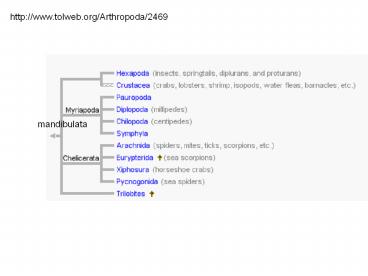Phylum Arthropoda - PowerPoint PPT Presentation
Title:
Phylum Arthropoda
Description:
Phylum Arthropoda Subphylum Trilobita Common 500 mya (4000 spp) but extinct by 225 mya Each body segment had a biramous appendage (inner for walking) ... – PowerPoint PPT presentation
Number of Views:125
Avg rating:3.0/5.0
Title: Phylum Arthropoda
1
http//www.tolweb.org/Arthropoda/2469
mandibulata
2
Phylum Arthropoda
- Subphylum Trilobita
- Common 500 mya (4000 spp) but extinct by 225 mya
- Each body segment had a biramous appendage (inner
for walking) - 3 body tagma
- Compound eyes with ommatidia
3
(No Transcript)
4
Trilobites flourished for 270 million years. They
died.
5
Subphylum Chelicerata
- Include spiders and mites and daddy LL,
scorpions, horseshoe crabs - Lack antennae
- 1st pair of appendages on the prosoma the
chelicerae (adapted for feeding)
6
Class Xiphosura Horseshoe crabs
- 4 spp, all marine
- Not true crabs (i.e., not crustaceans)
- head thorax prosoma or cephalothorax
- appendages of opisthosoma flattened to become
book gills for gas exchange
Telson
7
Class Arachnida
- Terrestrial
- Orders spiders, mites, ticks, scorpions, ddll
- 4 pairs of walking legs, one pair of pedipalps
- Head and thorax fused prosoma
- In ticks the prosoma and opisthosoma fuse
- carapace
8
Lymes Disease
Order Acari The ticks
- deer tick Ixodes scapularis is a vector for the
spirochete, Borrelia burgdorferi, from
white-footed mice (reservoir host) and people
9
Order Scorpiones
- Most ancient arachnid (and therefore most
primitive terrestrial arthropod) - Also the largest arachnid is a scorpion (18cm)
10
Class Arachnida, Order Scorpiones
A delicacy in Bankok, Thailand
11
Opisthosoma
Mesosoma
Prosoma
Metasoma
Eyes
Chelicera
Aculeus
Telson
Chela
Pedipalp
12
(No Transcript)
13
Class ArachnidaOrder Aranea (Spiders)
- Book gills internalized book lungs
- Spiracles and trachea
- Gas exchange does not require blood
- Spiders are specialized predators
- Poison glands, hollow chelicerae
- Silk glands, web building
- Spinneret are modified appendages
- 7 separate silk glands make different kinds of
silk
14
book lung
15
O. Pseudoscorpiones
No stinger
Dispersal by phoresy (hitchhike on houseflies)
Poison in chelae for immobilizing prey
16
Order Amblipygi
- First legs held out while they scurry sideways
- serve as tactile and chemoreceptors
Tailless whip scorpions are common in Costa Rica
17
Order Opiliones
18
Subphylum Mandibulata
- Class Myriapoda
- Order Chilopoda
- Order Diplopoda
- Class Insecta (Hexapoda)
- 33 orders
- Class Crustacea
- 6 subclasses
19
Myriapoda
- 1st head segment bears antennae
- 2nd head segment vestigial (no antennae)
- In crustacea this segment bears 2nd pair of
antennae - Gas exchange by trachea, spiracles on each body
segment - Not closable, risk of water loss
- Cuticle not waterproof more water loss
- Excretion by malpighian tubules
- Repugnatorial glands on ventrum
20
Order Chilopoda - centipedes
21
- Uniramous appendages, one per segment
- Spiracles cannot be closed to control water loss
Claws (modified legs) with poison glands for
immobilizing prey
mandibles
cephalon
Non-locomotory anal legs Defensive Sensory Aggress
ive
22
Diplopoda
- Diplosegments give the appearance of 2 pairs of
legs per segment - Lack poison claws
- Some produce cyanide defensive secretions































